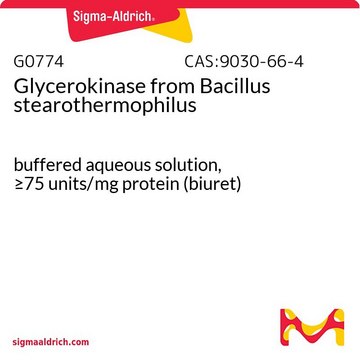G6278
Glycerokinase from Escherichia coli
300-600 units/mL, ammonium sulfate suspension
Synonym(s):
ATP:glycerol 3-phosphotransferase, Glycerol Kinase
About This Item
Recommended Products
biological source
Escherichia coli
Quality Level
form
ammonium sulfate suspension
concentration
300-600 units/mL
storage temp.
2-8°C
Looking for similar products? Visit Product Comparison Guide
General description
Glycerol kinase (GK) is a member of the FGGY carbohydrate kinase family (ATP: glycerol 3-phosphotransferase), which is responsible for transferring a phosphate group from ATP to glycerol.
Application
Biochem/physiol Actions
GK participates in the glycerol 3-phosphate shuttle and, in conjunction with glycerol 3-phosphate dehydrogenase, converts glycerol into dihydroxyacetone phosphate. It plays a pivotal role in plasma glycerol withdrawal, glycerol utilization by different tissues, and in maintaining carbohydrate homeostasis. GK is positioned at the nexus of lipid and carbohydrate metabolism and may play a potential role in type 2 diabetes mellitus (T2DM).
Unit Definition
Physical form
Signal Word
Danger
Hazard Statements
Precautionary Statements
Hazard Classifications
Resp. Sens. 1
Storage Class Code
11 - Combustible Solids
WGK
WGK 3
Flash Point(F)
Not applicable
Flash Point(C)
Not applicable
Personal Protective Equipment
Certificates of Analysis (COA)
Search for Certificates of Analysis (COA) by entering the products Lot/Batch Number. Lot and Batch Numbers can be found on a product’s label following the words ‘Lot’ or ‘Batch’.
Already Own This Product?
Find documentation for the products that you have recently purchased in the Document Library.
Customers Also Viewed
Articles
Instructions for working with enzymes supplied as ammonium sulfate suspensions
Our team of scientists has experience in all areas of research including Life Science, Material Science, Chemical Synthesis, Chromatography, Analytical and many others.
Contact Technical Service







